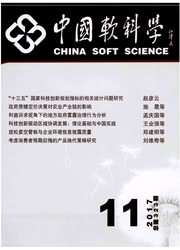

 中文摘要:
中文摘要:
近几年,有大量的文献对中国省份经济的全要素生产率(TFP)进行测算,本文对这些研究方法进行比较,说明这些研究一般忽视省份经济空间相关性和各区域生产函数差异问题。为解决这两个问题,本文引入空间分析的方法论,介绍了文献中较少采用的地理加权回归方法——GWR估计。进而,参考面板数据分析的优点,本文创新性地在GWR方法基础上,引入时间的概念,利用时空同质假设,提出新的地理加权回归方法:三维或同质的时空地理加权回归方法,简称HGTWR方法。运用HGTWR方法,本文对1998—2005年我国省份经济TFP进行估计。估计结果说明:我国区域经济的总量生产函数是随时空而变化的;省份经济TFP增长率和贡献度呈“西-中-东”排列;我国经济增长中TFP增长率和贡献度并不低,说明我国近期经济增长并非是低效增长。
 英文摘要:
英文摘要:
The fast development of China has recently attracted increasing interests from scholars. A large body of literature has investigated the methods of measuring the growth of China' s provincial Total Factor Productivity (TFP) based on the Solow Residual of a production function. Most of these approaches, however, ignore the possible spatial interaction and heterogeneity inherently existed in geographical observations. The current study hence for the first time introduces the Geographically Weighted Regression (GWR), which handles well the spatial interaction and heterogeneity, to measure the growth of China' s provincial TFP. Yet it is recognized that there are only 31 cross -sectional provincial units in Mainland China. The analyzing size might not be enough to reflect the inherent spatial effects. On the other hand, we have a set of panel data from 1997 - 2005, which enables us to introduce the time axis to regular cross - sectional GWR analysis. We hypothesize that the spatial and temporal axes are homogeneous in representing the interaction and heterogeneity among observations in space and time. Based on such hypothesis, we are able to extend the cross - sectional GWR to a so -called three dimensional geographically weighted regression, or Homogenized Geographically and Temporally Weighted Regression (HGTWR). Based on the HGTWR, we derived the growth of China' s provincial TFPs and their contributions to economic development. It is found that in general, the growth of TFP and its contribution to China' s economic development are rather high, which indicates the recent economic growth in China is not likely a low - efficient growth. Furthermore, the HGTWR indicates that the growth of TFP might contribute differently to economic development in different provinces and time periods. On average, from 1998 -2005, the growth of TFP seems to be more important to economic development in the Western China than the Central and East regions. Such contribution continues to increase in China, which furthe
 同期刊论文项目
同期刊论文项目
 同项目期刊论文
同项目期刊论文
 期刊信息
期刊信息
